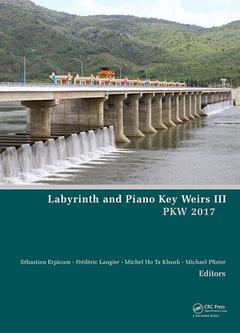Description
Labyrinth and Piano Key Weirs III
Proceedings of the 3rd International Workshop on Labyrinth and Piano Key Weirs (PKW 2017), February 22-24, 2017, Qui Nhon, Vietnam
Coordinators: Erpicum Sébastien, Laugier Frédéric, Ho Ta Khanh Michel, Pfister Michael
Language: English
Subject for Labyrinth and Piano Key Weirs III:
Keywords
Piano Key Weirs; physical and numerical modeling; Labyrinth Weirs; hydraulic and structural design; Discharge Coefficient; research and development; Outlet Keys; hydraulics; Inlet Key; geometry; Weir Side; energy dissipation; Discharge Capacity; future applications and developments; Downstream Overhangs; construction; Upstream Head; Stilling Basin; Submerged Flow Conditions; Weir Heights; Crest Length; Weir Crest; Downstream Water Level; Weir Types; Scour Depth; Pk Weir; Linear Weir; Left Bank; Total Upstream Head; Unit Discharge; Maximum Scour Hole Depth; Maximum Scour Depth; Crest Shape
· 17.4x24.6 cm · Hardback
Description
/li>Contents
/li>Readership
/li>Biography
/li>
Since the first implementation by Electricité de France on the Goulours dam (France) in 2006, the Piano Key Weir has become a more and more applied solution to increase the discharge capacity of existing spillways. In parallel, several new large dam projects have been built with such a flood control structure, usually in combination with gates. Today, more than 25 Piano Key Weirs are in operation or under construction all over the world. More than 15 years of research and development have enabled detailed investigations of the hydraulic and structural behaviour of the Piano Key Weir complex structure and have provided more and more accurate design equations. Following the proceedings of the first two workshops held in Liege (Belgium ? 2011) and Paris (France ? 2013), Labyrinth and Piano Key Weirs III collects the contributions presented by people with varied background, from researchers to practitioners, at the 3rd International Workshop on Labyrinth and Piano Key Weirs - PKW 2017 (22-24 February 2017, Qui Nhon, Vietnam). The papers, reviewed and accepted by an International Scientific Committee, summarize the current state-of-the-art on Piano Key Weirs from a theoretical to a practical point of view, and present most of the main projects in operation or under construction.
Labyrinth and Piano Key Weirs III is thus a reference for students, practitioners and researchers interested in Dams Engineering.
Keynotes, Research and development, Geometry, Hydraulics, Fluid-Structure interactions and aeration, Energy dissipation, Future applications and developments, Projects, Studies, Constructions.
Sebastien Erpicum is Assistant Professor at the Laboratory of Engineering Hydraulics – HECE, University of Liege. He graduated in Civil Engineering at the University of Liege (ULg), Belgium, in 2000. After joining the HACH research unit at the ULg as a research engineer, he obtained his PhD on the subject of free surface turbulent flow numerical modelling with multiblock grids in 2006. He then worked as a senior researcher, involved in many combined numerical / physical studies of dams and hydropower plants all over the world, and spent 6 months at the IWW-RWTH in Germany. Since 2010, he is in charge of the Laboratory of Engineering Hydraulics in the new research group on Hydraulics in Environmental and Civil Engineering – HECE of the ULg and has been appointed as Assistant Professor in 2015. His field of activities covered the complementary domains of education, research and services in applied hydraulics, considering both numerical and physical modelling approaches.
Frédéric Laugier is head of the Structural Branch of the Technical Direction at Electricité de France – Hydro Engineering Center, EDF-CIH. He graduated in Civil Engineering from the Ecole Nationale of the Ponts and Chaussées (ENPC) in Paris (France) in 1996. His final year was spent at Imperial College, London, through the Erasmus exchange programme. He joined the EDF Hydro Engineering Centre in 1998. As a design engineer and project leader he has taken part in various civil engineering and hydro engineering projects, including the rehabilitation and maintenance of existing EDF dams. He was the Project Leader of the design and construction of the first two PK Weirs built on the Goulours and Saint-Marc dams in France. From 2008 to early 2011 he also was General Secretary of the French Committee of Large Dams. He is currently head of structural branch of technical direction of EDF Hydro Engineering Center.
Michel Ho Ta Khanh is
These books may interest you

Labyrinth and Piano Key Weirs II 178.41 €

Labyrinth and Piano Key Weirs 87.11 €


